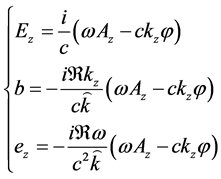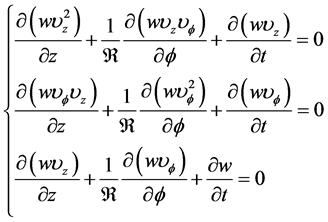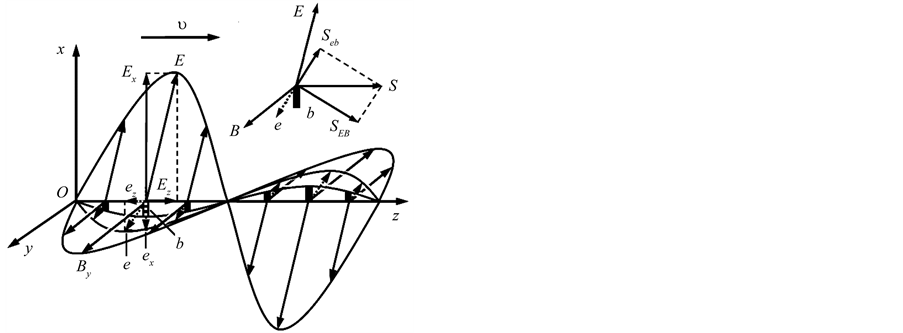Open Access Library Journal
Vol.02 No.07(2015), Article ID:68519,23 pages
10.4236/oalib.1101732
The Unified Theoretical Form of Massive Electrodynamics
Qiankai Yao1,2
1School of Physics and Engineering, Zhengzhou University, Zhengzhou, China
2College of Science, Henan University of Technology, Zhengzhou, China
Email: yaoqk@zzu.edu.cn
Copyright © 2015 by author and OALib.
This work is licensed under the Creative Commons Attribution International License (CC BY).
http://creativecommons.org/licenses/by/4.0/


Received 9 July 2015; accepted 24 July 2015; published 31 July 2015

ABSTRACT
Based on the mechanism of vacuum polarization, we here establish a set of new electromagnetic field equations (EFEs) in 5-dimensional Minkowski coordinate system, which can be used to consider some physical implications, such as the dispersion, the polarized states and the Hubble redshift of massive photon. It shows that, the effective mass of photon is related to the Hubble constant H, and finally determined by its unit spin ħ. Importantly, these obtained equations, working as a generalization of Maxwell’s equations (MEs), enable us to develop the special relativity into 5-dimensional form. In developed relativity, the particle spin will voluntarily go into the motion equation, since it plus the linear momentum and energy can just form a 5-dimensional covariant vector. Moreover, by reorganizing the conservation laws of generalized electrodynamics, we find that the Hamiltonian of massive photon is similar to the Dirac formation. This similarity allows us to construct a new Dirac typical equation to study the motion of massive photon from a standpoint of Dirac theory.
Keywords:
Vacuum Polarization, Massive Electrodynamics, Dirac Typical Equation
Subject Areas: Theoretical Physics

1. Introduction
A basic implication of Maxwell’s theory is that, all electromagnetic radiations propagate in vacuum at a constant velocity c. This conclusion was further raised to the postulate of special relativity, and soon after that described successfully as the moving behavior of massless photon by quantum theory. Despite all these, a substantial experimental effort [1] [2] has been made to measure the mass of photon  (we shall see below that, for being determined by unit spin
(we shall see below that, for being determined by unit spin ,
,  would be treated as the spin (or effective) mass of photon rather than the conventional one; it is noticed that its conventional mass is still zero). If the effective mass of photon was found to be nonzero, it would produce an effect on the contemporary physical theories [3] [4] ; for example, the special relativity must be modified to suit massive photon [5] .
would be treated as the spin (or effective) mass of photon rather than the conventional one; it is noticed that its conventional mass is still zero). If the effective mass of photon was found to be nonzero, it would produce an effect on the contemporary physical theories [3] [4] ; for example, the special relativity must be modified to suit massive photon [5] .
Now, it is considered to be almost certainly impossible to do any experiment to confirm the value of . The best one can hope to do is to place ever tighter limits on its size, since it might be so small that none of the present experimental strategies could detect it. According to the uncertainty principle, the ultimate upper limit on
. The best one can hope to do is to place ever tighter limits on its size, since it might be so small that none of the present experimental strategies could detect it. According to the uncertainty principle, the ultimate upper limit on  is estimated to be
is estimated to be , as taking the time uncertainty
, as taking the time uncertainty  of the universe age of about 1010 years [1] . Although such an infinitesimal mass would be extremely difficult to detect, there are still some implications, such as a Yukawa type of potential, a frequent dependence of light speed, to be worth paying attention, and all of these have been studied seriously [6] . All the works in this area have opened a door to useful approaches for laboratory experiments or cosmological observations aimed at determining the effective mass of photon or, more precisely, setting an upper limit on it. And from the standpoint of testing for a photon mass, the key point, as a direct consequence of nonzero photon mass, is one of searching for frequency dispersion of the speed of light [1] . For example, The results of several pulsar measurements by Bay and White [7] placed a rough upper limit on the photon mass of
of the universe age of about 1010 years [1] . Although such an infinitesimal mass would be extremely difficult to detect, there are still some implications, such as a Yukawa type of potential, a frequent dependence of light speed, to be worth paying attention, and all of these have been studied seriously [6] . All the works in this area have opened a door to useful approaches for laboratory experiments or cosmological observations aimed at determining the effective mass of photon or, more precisely, setting an upper limit on it. And from the standpoint of testing for a photon mass, the key point, as a direct consequence of nonzero photon mass, is one of searching for frequency dispersion of the speed of light [1] . For example, The results of several pulsar measurements by Bay and White [7] placed a rough upper limit on the photon mass of .
.
In quantum field theory [8] , the electromagnetic fields (EFs) have been successfully described as the neutral massless photon with unit spin . However, for massive photon [9] [10] , it would require a set of new equations, which was proposed by Proca at first [11] . In Proca theory, the Lorentz condition is automatically held, but gauge invariance would be inevitably lost. So that, once the photon was confirmed to be massless, no matter large or small, it would have a bearing on some fundamental physical questions [5] [12] . In Section 2, we will establish a set of new equations to describe massive electromagnetic fields (MEFs), whose consequent distinctness compared with purely Maxwell equivalents is presented. In Section 3, the wave solutions of MEFs are given, which can naturally lead to the Hubble redshift in cosmology. Sections 4 and 5 introduce the developed relativity and massive electrodynamics; Section 6 presents the Dirac typical equation of massive photon.
. However, for massive photon [9] [10] , it would require a set of new equations, which was proposed by Proca at first [11] . In Proca theory, the Lorentz condition is automatically held, but gauge invariance would be inevitably lost. So that, once the photon was confirmed to be massless, no matter large or small, it would have a bearing on some fundamental physical questions [5] [12] . In Section 2, we will establish a set of new equations to describe massive electromagnetic fields (MEFs), whose consequent distinctness compared with purely Maxwell equivalents is presented. In Section 3, the wave solutions of MEFs are given, which can naturally lead to the Hubble redshift in cosmology. Sections 4 and 5 introduce the developed relativity and massive electrodynamics; Section 6 presents the Dirac typical equation of massive photon.
2. Massive Electromagnetic Field Equations
In Maxwell’s theory, electromagnetic phenomena are always characterized by the electric and magnetic fields (E, B), which are thought of as the quantum of light in term of photon. If photon is massive instead of massless, its motion equations would become Proca form (in the Heaviside-Lorentz system of units) [13] [14]
 (2.1)
(2.1)
where,  , A denote the electromagnetic potentials,
, A denote the electromagnetic potentials,  indeed reflects the effective range of electromagnetic interaction. After that, Proca equations (PEs) have provided the pathway for almost all approaches to detect the photon mass. Specifically, due to
indeed reflects the effective range of electromagnetic interaction. After that, Proca equations (PEs) have provided the pathway for almost all approaches to detect the photon mass. Specifically, due to , A being observable, Proca theory would lose its proper gauge invariance. Because of the nonzero photon mass, the dispersion produces a frequency dependence [15]
, A being observable, Proca theory would lose its proper gauge invariance. Because of the nonzero photon mass, the dispersion produces a frequency dependence [15]
 (2.2)
(2.2)
 is the angular frequency, k the wave number. This frequent dependence could be used to determine the photon mass in experiments [16] [17] .
is the angular frequency, k the wave number. This frequent dependence could be used to determine the photon mass in experiments [16] [17] .
The quantum theory can provide a basis for massive electromagnetic theory, since according to the theory, vacuum is not empty, but filled with a large number of virtual particle-antiparticle pairs flashing in and out of existence [18] . Generally, these pairs may not bring any effect, whereas in the presence of external fields, they could be pulled away directionally. Such the situation strongly suggests that, the vacuum should be treated as a kind of dielectric, and thus, when the external fields applied, the polarization charge  and current
and current  are produced. To take account of the physical consequence of vacuum polarization, we need to rewrite MEs as
are produced. To take account of the physical consequence of vacuum polarization, we need to rewrite MEs as

These equations can be further expressed in 5-dimensional Minkowski space with an extra-dimension 




Now, we introduce a polarized vector field 

and note that, the positive and negative charge elements 




where 



It shows that, the charge is conserved in space



called generalized Maxwell’s equations (GMEs). The performance of massive electromagnetic induction can be summarized as follows:
1) Varying magnetic and polarized scalar fields generate respectively an electric and a polarized vector fields, described by Equations (b) and (e).
2) Varying electric field generates a magnetic field and a polarized vector field, by Equation (d).
3) Varying polarized vector field generates a polarized scalar and an electric fields, by Equation (g).
Figure 1. The 4th coordinate f is related to particle spin.
GMEs can provide a complete and self-consistent description of electromagnetic phenomena, and help us to calculate the stress of current 

with






Now, by the 5-dimensional potential

but need to supply a generalized Lorentz condition

It is easy to verify that, MEFs still have gauge invariance under the generalized transformation of 



which has the following retarded solution

for current 

3. Implications of Massive Photon
3.1. The Yukawa Potential
The first consequence of MEFs is related to a static electric field, that is, under the static condition of

For a point charge

with an exponential decay range of
3.2. The Dispersion of Light
It is important that, the electromagnetic induction described by Equation (2.7) can make MEFs spread in vacuum as free wave

The most typical aspect of massive photon is its frequent dependence (corresponding to Equation (2.2))






both tend to c together, only as
By generalized wave vector of

where, 



They have the same value of c. However, when projecting to the real space, the two occur immediately differentiation, since one is displayed as a direct projection, the other represents the velocity of the intersection point of wave surface and z-axis moving along the axis (see Figure 2).
From the geometric relation above, we find

In the case of


Figure 2. Physical meaning of the group and phase velocities is presented in generalized space
generalized space moving with velocity c. Correspondingly, the two velocities along f-axis can be given by

Then we have

For nonzero mass 


with a total wave number




we get

Clearly, for the photon of zero Compton wave number
3.3. The Field Structures of MEWs
Maxwell’s theory points out two polarized directions, both of which are orthogonal to the propagating direction of photon. However, MEWs described by PEs would result in a third state of polarization, in which the electric field points along the line of motion, corresponding to longitudinal photon [21] . Here, we still approve the third polarized state, but emphasize that, there will be three types of electromagnetic oscillations propagating along z-axis, those are pure transverse wave (PTW), pure longitudinal wave (PLW) and longitudinal-transverse mixed wave (LTMW). These waves possess a general solution

a) Pure transverse wave. For PTW with generalized potential of

The determined energy flows can be written as the energy density w multiplied by its traveling velocity

in agreement with Equation (2.9). When the polarized fields (
b) Pure longitudinal wave. Correspondingly, the potential of PLW reads

gives the following nonzero field components

The energy flows come mainly from the polarized fields, namely

It tells us that, as a special radiation involving the polarized fields (

Figure 3. The field structures of PTW (a) and PLW (b) (dotted arrow and black stick denote polarized vector and scalar fields).
radiation) has no classical correspondence, but represents a natural induction process: Varying polarized vector field generates the polarized scalar and electric fields, in turn, when the latter two change, the former is induced. Figure 3(b) presents the structure of PLW.
c) Longitudinal-transverse mixed wave. With regard to LTMW of potential

followed by the flows just along the travelling direction of photon (see Figure 4).

However, in Proca theory, the situation is completely different, since it only gives three field components

with an energy flow defined by [21] [22]

not along the direction of wave vector
3.4. AB and AC Effects of MEFs
A well-known topological interference effect is called AB effect, which concerns a phase shift for moving elec-
Figure 4. Due to containing all the four fields, LTMW with E, e in Oxz plane and B parallel to y-axis, possesses a more complex structure.
trons (mass


where the vector potential 










An extension of the AB effect was presented by Aharonov and Casher [24] , called AC effect, which emphasizes that, a neutral particle possessing a magnetic dipole moment should experience an analogous phase shift when diffracted around a line of electric charge. Consider a magnetic dipole with mass 



The corresponding phase shift of the split beam at the recombination point reads

The shift for this case is shown to reduce smoothly to that of the standard AC effect in the limit of vanishing photon mass, as was observed in the neutron interferometry experiment [25] . An additional effect is predicted from

where, 
3.5. Effect of Spectral Shift
Vacuum polarization field not only can delay movement of photon, but require a generalized form of flow conservation, that is


with a damping solution



Such the effect was first discovered by Hubble in astronomical observation [27] , that is formulated as Hubble law: the recession velocity of celestial body 



Because of having cosmological meaning, we can use the astronomical observation (i.e. Hubble constant H) to affirm the effective mass of photon

just equal to its ultimate upper limit estimated by uncertainty principle. This mass is determined by spin
4. A Generalization of Relativity for Massive Photon
Special relativity is the theory of how different observers, moving at constant velocity with respect to one another, report their experience of the same physical event. And all the descriptions are completely based on the following two postulates:
I. The laws of physics take the same form in every inertial frame;
II. The speed of light in vacuum is the same in every inertial frame.
However, in massive electromagnetic theory, the speed of light is dependent of frequency rather than a unique constant. Thus, there needs a new postulate to be proposed to restore the features of special relativity, and the proposed should be aimed at the existence of a unique limiting speed c, to which speeds of all bodies tend when their energy becomes much larger than their mass [5] [12] . Now, by the fact of that MEWs are always propagating at speed c in generalized space
The generalized speed of light is a constant c.
4.1. Generalized Lorentz Transformation
The modified postulate inspires us to discuss motion in 5-dimensional Minkowski space

Here, the invariance means every inertial observer would obtain the same value for this particular combination. The interval 




The rest-frame time coordinate 

gives

where 
In order to contain completely such that, GMEs should keep the same form, and the modified transformation for coordinates




GMEs have Lorentz symmetry because they are covariant under such the transformation (called generalized Lorentz transformation (GLT)), instead of the usual one.
A further 5-vector is the 5-velocity

with an invariant length of

Its components transform into each other under GLT in the same manner as 

With the help of GLT, we can get the basic formula for velocity addition as follows:

In particular, if generalized speed 


This is just a restatement of the fact that, if a particle (or light) has 

4.2. Generalized Relativistic Dynamics
In order for relativistic mechanics to be Lorentz symmetric, we need to generalize the familiar 4-momentum 


with an invariant length of











Moreover, we also have another 4th component of velocity

The first result guarantees 
very small velocity 

Now, by the invariant length of

which naturally contains particle spin


meaning only zero mass particle can travel at speed c in generalized space, i.e.


In 5-dimensional relativity, all the related concepts can be given by analogy with their corresponding relativistic versions. Thus, we define the generalized force by

In the case of



The rate at which the generalized force does work is then



By requiring that 


As should be the case, the generalized energy tends to the classical form for moving particle with a small velocity
When particle is force-free

of which, the 4th component 









In particularly, for 




Nevertheless, the truly remarkable aspect of the above conclusions is that it has its fundamental origin in the fact that there exists a universal maximum possible speed c and a characteristic length
4.3. Lagrangian Description
With 


By potential

and further manipulated into the Lagrange’s form

with the Lagrangian

For zero spin particle of

To derive the Hamiltonian H for charged particle in MEFs, we write the canonical momentum

Then, applying Legendre transform to 

Consider the energy-momentum relation 


followed by Hamilton’s equations:

These equations are first-order in time in contrast to the second-order Lagrange’s.
5. Massive Electrodynamics
It is natural that, the electrodynamics of moving bodies could be in agreement with the developed relativistic principles, under which all the related problems could be discussed. In particularly, when we say GMEs are covariant, we eventually must specify the transform properties of that, it is not only the space and time coordinates that will change, but also MEFs.
5.1. Covariant Electromagnetic Equations
The clue we need to construct a transparently covariant comes from GMEs, whose structure guarantees that the equations are form-invariant to translations in generalized space. Therefore, to show that massive electrodynamics is covariant, it is sufficient to show that the fundamental equations can be written entirely in terms of Lorentz tensors, whose components change under a Lorentz boost. The path to writing GMEs in covariant form begins with the introduction of the MEF tensor

Of which, the components transform according to the rule of

including continuity equation 


The variation of the density with respect to 

Now, it is easy to confirm that, the tensor transformation rule applied to 

Also noteworthy is the Lorentz invariant scalar function

The presented results reflect the transform properties of MEFs. The approach can provide us all the knowledge of generalized electrodynamics.
5.2. Generalized Conservation Laws
In order to organize the conservation laws of electromagnetism, we write the stress of 5-current 

and then get



To examine the elements of

The latter just simplifies to the negative of electromagnetic energy density w. The off-diagonal elements 

A bit of algebra confirms that the space-phase components 

Furthermore, the space-space components can be given by

Putting all the presented results together gives the matrix of 

With the representation (5.13) in hand, it is straightforward to confirm that Equation (5.7) contains two conservation laws in differential form. The first is a statement of the conservation of generalized momentum

The second gives Poynting’s theorem of energy conservation

Now, with the help of Equation (5.13), it is easy to write out the stress-energy tensor of plane MEWs discussed in Section 3, that is

So, we have the following conservation equations

corresponding to a steady form

due to

Treating H as the Hubble constant gives

with 





The generalized full speed of light is a constant c.
By the postulate, we can incorporate the presented theoretical form into a more generalized unified framework of spatial relativity [29] , the unified framework could give a satisfactory account of the relativistic phenomena.
5.3. Angular Momentum and Center of Energy
Now, by force (5.6) we define the generalized Lorentz torque density tensor as

The structure of this anti-symmetric tensor is

Analogous to Equation (5.7), it is possible to write the second-rank torque density as the five divergence of a generalized third-rank Lorentz tensor:

The anti-symmetry of 




or given by

We focus on the 30 components 





Now, let us investigate the similarity between an electromagnetic pulse and a relativistic particle. When no source exists

followed by the conservation equations

In which, the conserved quantities are defined as the angular momentum flow densities of massive electromagnetic radiations, 



with


It can help us to write Equation (5.27) in term of Poisson formulation (due to


with Poisson brackets defined respectively by

It suggests that, when the brackets with the Hamiltonian vanish, the generalized angular momentums of moving photon will be constant.
6. Toward a Dirac Typical Equation
In this section, our aim will be try to construct a Dirac typical equation to describe the motion of photon. Along the way, we shall encounter some challenges, which ultimately will force us to a recasting of Dirac equation.
6.1. Generalized Dirac Equation
To combine relativistic invariance with quantum mechanics, let us to write out the generalized Dirac Hamiltonian of 

with an explicit representation of Hermitian 

in term of the 




To study the interaction of a Dirac particle with an external MEF characterized by potential

where the 



with 



Multiplying it by the operator 

with a generalized spin tensor defined by

whose components read

The 10 matrices of 



When the polarized fields neglected (i.e.

6.2. Dirac Typical Equation of Free MEW
It is easy to find the similarity between Hamiltonian (5.29) and the Dirac formation. This similarity would provide us a very useful analytical device to study the angular momentum of photon from standpoint of Dirac theory. Thus, based on the fact that, the 3rd component of photon spin is always parallel to its momentum 



and write the generalized Hamiltonian operator of photon as

where, 



Now, it is easy to find that, the generalized angular momentum of photon 

To meet the requirement, we introduce the 

and define the generalized spin tensor of photon by

The definition allows us to treat the total angular momentum 


implying five conserved components, namely

Accordingly, MEWs behave like relativistic particles in the sense that their angular momentum transform like the energy-momentum vector of a particle. The situation suggests the conversation law of angular momentum should be modified as: the nature of MEWs is no longer to keep the generalized



To study the physical implication of the Hamiltonian (6.12), we introduce a 5-dimensional bispinor 

We here emphasize: 1) The components of 
MEW with 

is conserved and whose firth component is a positive density of photon. So that, in the 5-dimensional representation (6.15), 

in terms of two-component spinors 


Solving the equation gives its eigensolutions and the corresponding eigenvalues (shown as Table 1).
Table 1. The eigensolutions of Equation (6.21).
where, the spin states 


the parameter 

From the above, we find a 4D mixed representation of consisting of the energy symbol (±) and the spin chirality

Then by Equation (6.19) and its conjugate form

we get conservation equation

The number density of photon 

It is interesting to notice the equivalence between the covariant form of Equation (6.19)

and the homogeneous d’Alembert’s,

including the stress-energy one

For plane MEWs of 

and then get the nonzero field components (corresponding to Equation (3.22))

followed by the energy density

identical to expressions (3.23) and (6.26). The transverse and longitudinal fields in (6.31) represent respectively PTW and PLW, and coexistence of the both will bring us LTMW.
Up to now, we have transformed GMEs into Dirac form, which practically identical but conceptually different with the usual electrodynamics, looks upon MEWs from a viewpoint of quantum physics: MEWs are nothings but a collection of a large number of massive photon with unit spin, which can be described by a Dirac typical equation. Importantly, we find a new route that can be followed to study the motion of photon in the mathematical clothes of Dirac theory.
7. Summary
In this paper, we have made a special effort to illustrate the physical consequences of vacuum polarization. This practice could provide a direct pathway to develop Maxwell’s theory, and the development has leaded to many surprising results. To sum up, these results are:
1) The starting point of our work is to establish a set of new EFEs by the mechanism of vacuum polarization, which is expressed in generalized space with an added dimension identified with the spin phase, hence possessing gauge invariance. These equations could give us a complete and self-consistent description of electromagnetic phenomena.
2) The effects of massive photon were incorporated into electromagnetism straightforwardly through GMEs, which can be used to consider some physical implications, such as deviations in the behavior of static electromagnetic fields, the dispersion of light, the polarized states of MEWs and the Hubble redshift. In particularly, we emphatically discuss the field structures of three typical MEWs, i.e. the pure transverse, pure longitudinal and longitudinal-transverse mixed waves.
3) By a modified relativistic postulate of that: The generalized speed of light is a constant c, we develop the special relativity into a 5-dimensional Lorentz symmetric form; this form contains two natural constants: a velocity constant c and a length constant
4) To guarantee electrodynamics to be covariant, we have written entirely the fundamental equations of the subject in terms of Lorentz tensors, whose components change under a Lorentz boost, but whose essential tensor character does not change. The covariant notation provides a powerful way to organize the conservation laws of electromagnetism for the linear momentum, angular momentum and energy, including a further revisiting by Lagrangian method.
5) By reevaluating the similarity between the energy form of photon and the Hamiltonian of Dirac particle, we constructed a Dirac typical equation for free massive photon. The plane wave solutions of the equation are presented, which could bring a significant change to electrodynamics.
Finally, let us review the developed electrodynamics. The original equations (i.e. MEs) were not accurate and had to be reformulated. The modified equations (i.e. GMEs) were involved in a generalized field formulation. This field formulation always gives the same results when applied to the different frameworks, and thus the Lorentz covariance is guaranteed.
Cite this paper
Qiankai Yao, (2015) The Unified Theoretical Form of Massive Electrodynamics. Open Access Library Journal,02,1-23. doi: 10.4236/oalib.1101732
References
- 1. Tu, L.C., et al. (2005) The Mass of the Photon. Reports on Progress in Physics, 68, 77.
http://dx.doi.org/10.1088/0034-4885/68/1/R02 - 2. Zhang, Y.Z. (1998) Special Relativity and Its Experimental Foundations. World Scientific Press, Singapore.
- 3. Feynman, R.P. (1949) The Space-Time Approach to Quantum Electrodynamics. Physical Review Letters, 76, 769.
http://dx.doi.org/10.1103/PhysRev.76.769 - 4. Strocchi, F. (1967) Gauge Problem in Quantum Field Theory. Physical Review Letters, 162, 1429.
http://dx.doi.org/10.1103/PhysRev.162.1429 - 5. Goldhaber, A.S. and Nieto, M.M. (1971) Terrestrial and Extra-Terrestrial Limits on the Photon Mass. Reviews of Modern Physics, 43, 277.
http://dx.doi.org/10.1103/RevModPhys.43.277 - 6. Masood, S.S. (1991) Photon Mass in the Classical Limit of Finite-Temperature and -Density QED. Physical Review E, 44, 3943.
Mendonca, J.T., et al. (2000) Field Quantization in a Plasma: Photon Mass and Charge. Physical Review Letters, 62, 2989. - 7. Bay, Z. and White J.A. (1972) Frequency Dependence of the Speed of Light in Space. Physical Review D, 5, 796.
http://dx.doi.org/10.1103/PhysRevD.5.796 - 8. Greiner, W. and Reinhardt, J. (1996) Field Quantization. Springer, New York.
http://dx.doi.org/10.1007/978-3-642-61485-9 - 9. Eidelman, S., et al. (2004) Review of Particle Physics. Physics Letters B, 592, 1-5.
http://dx.doi.org/10.1016/j.physletb.2004.06.001 - 10. Tu, L.C., et al. (2006) Test of U(1) Local Gauge Invariance in Proca Electrodynamics. Physics Letters A, 352, 267-271.
http://dx.doi.org/10.1016/j.physleta.2005.12.017 - 11. Proca, A. (1930) Fundamental Equations of Elementary Particles. Comptes Rendus, 190, 1377.
- 12. Singleton, D. (1996) Does Magnetic Charge Imply a Massive Photon. International Journal of Theoretical Physics, 35, 2419-2426.
http://dx.doi.org/10.1007/BF02085749 - 13. Jackson, J.D. (1976) Classical Electrodynamics. John Wiley & Sons, Hoboken.
- 14. Cheng, T.P. (2005) Relativity, Gravitation and Cosmology. Oxford University Press, Oxford.
- 15. Jackson, J.D. (1987) The Impact of Special Relativity on Theoretical Physics. Physics Today, 40, 34.
http://dx.doi.org/10.1063/1.881108 - 16. Hollweg, J.V. (1974) Improved Limit on Photon Rest Mass. Physical Review Letters, 32, 961.
http://dx.doi.org/10.1103/PhysRevLett.32.961 - 17. Schaefer, B.E. (1999) Severe Limits on Variations of the Speed of Light with Frequency. Physical Review Letters, 82, 4964.
http://dx.doi.org/10.1103/PhysRevLett.82.4964 - 18. Prokopec, T., et al. (2002) Photon Mass from Inflation. Physical Review Letters, 89, 101301.
http://dx.doi.org/10.1103/PhysRevLett.89.101301 - 19. Wesson, P.S. (1984) An Embedding for General Relativity with Variable Rest Mass. General Relativity and Gravitation, 16, 193-203.
http://dx.doi.org/10.1007/BF00762447 - 20. Gao, C.S. and Zeng, J.Y. (1990) Particle Physics and Nuclear Physics. Higher Education Press, Beijing.
- 21. Greiner, W. and Reinhardt, J. (1996) Field Quantization. Springer, New York.
http://dx.doi.org/10.1007/978-3-642-61485-9 - 22. Nieuwenhuizen, P. (1973) Radiation of Massive Gravitation. Physical Review D, 7, 2300.
http://dx.doi.org/10.1103/PhysRevD.7.2300 - 23. Aharonov, Y. and Bohm, D. (1959) Significance of Electromagnetic Potentials in the Quantum Theory. Physical Review, 115, 485.
http://dx.doi.org/10.1103/PhysRev.115.485 - 24. Aharonov, Y. and Casher, A. (1984) Topological Quantum Effects for Neutral Particles. Physical Review Letters, 53, 319.
http://dx.doi.org/10.1103/PhysRevLett.53.319 - 25. Cimmino, A., et al. (1989) Observation of the Topological Aharonov-Casher Phase Shift by Neutron Interferometry. Physical Review Letters, 63, 380.
http://dx.doi.org/10.1103/PhysRevLett.63.380 - 26. Fuchs, C. (1990) Aharonov-Casher Effect in Massive-Photon Electrodynamics. Physical Review D, 42, 2940.
http://dx.doi.org/10.1103/PhysRevD.42.2940 - 27. Hubble, E. (1929) A Relation between Distance and Radial Velocity among Extragalactic Nebulae. Proceedings of the National Academy of Sciences of the United States of America, 15, 168-173.
http://dx.doi.org/10.1073/pnas.15.3.168 - 28. Sandage, A., et al. (1996) Cepheid Calibration of the Peak Brightness of Type Ia Supernovae. The Astrophysical Journal Letters, 460, L15-L18.
http://dx.doi.org/10.1086/309973 - 29. Yao, Q.K. (2015) The Spatial Relativity and Its Physical Consequences. Open access Library Journal, 2, e1286.
http://dx.doi.org/10.4236/oalib.1101286 - 30. Itzykson, C. and Zuker, J.B. (1980) Quantum Field Theory, McGraw-Hill Inc., New York.










